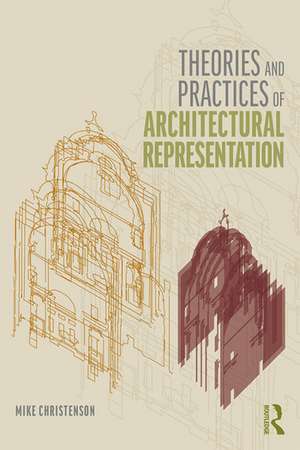Theories and Practices of Architectural Representation
Autor Mike Christensonen Limba Engleză Paperback – 8 apr 2019
This book considers essential questions including: How does architecture become known? How is knowledge about architecture produced, structured, disseminated, and consumed? How in particular do historical patterns of knowledge production persist within contemporary culture and society? How are these patterns affected by changes in technology, and how does technology create new opportunities? These questions are examined through five chapters dealing with exemplary buildings and representational methods selected from worldwide locations including the United States, Japan, and Italy.
Theories and Practices of Architectural Representation proposes that historical theories and practices of architectural representation remain distinct, robust, and uniquely viable within the context of rapidly changing technologies. It is an essential read for students of architectural theory of representation.
| Toate formatele și edițiile | Preț | Express |
|---|---|---|
| Paperback (1) | 309.97 lei 6-8 săpt. | |
| Taylor & Francis – 8 apr 2019 | 309.97 lei 6-8 săpt. | |
| Hardback (1) | 999.46 lei 6-8 săpt. | |
| Taylor & Francis – 8 apr 2019 | 999.46 lei 6-8 săpt. |
Preț: 309.97 lei
Nou
Puncte Express: 465
Preț estimativ în valută:
59.33€ • 64.47$ • 49.87£
59.33€ • 64.47$ • 49.87£
Carte tipărită la comandă
Livrare economică 21 aprilie-05 mai
Preluare comenzi: 021 569.72.76
Specificații
ISBN-13: 9781138055889
ISBN-10: 1138055883
Pagini: 200
Ilustrații: 20 Line drawings, black and white; 20 Halftones, black and white; 44 Illustrations, black and white
Dimensiuni: 156 x 234 x 15 mm
Greutate: 0.32 kg
Ediția:1
Editura: Taylor & Francis
Colecția Routledge
Locul publicării:Oxford, United Kingdom
ISBN-10: 1138055883
Pagini: 200
Ilustrații: 20 Line drawings, black and white; 20 Halftones, black and white; 44 Illustrations, black and white
Dimensiuni: 156 x 234 x 15 mm
Greutate: 0.32 kg
Ediția:1
Editura: Taylor & Francis
Colecția Routledge
Locul publicării:Oxford, United Kingdom
Cuprins
Preface
Introduction
1 Interface
2 Time
3 Deformation
4 Iteration
5 Accident
6 Reflection
Index
Introduction
1 Interface
2 Time
3 Deformation
4 Iteration
5 Accident
6 Reflection
Index
Notă biografică
Mike Christenson, AIA, Professor of Architecture at the University of Minnesota, is the author of the book Beginning Design Technology (Routledge, 2016), a member of the Board of Directors of the Association for Computer-Aided Design in Architecture, and Associate Editor for Architectural Computing for the journal Architectural Science Review.
Recenzii
"In Theories and Practices of Architectural Representation, Mike Christenson provides a well-written, thorough introduction to the many complex ways architectural representation and architecture are inextricably entwined and, in some ways, identical. With thoughtful discussions of numerous well-chosen examples, he reminds architects that representations are never transparent or neutral, that we must constantly ask ourselves 'what does representation obscure, what does it silence, and what does it omit?'"
David Ross Scheer, author of The Death of Drawing: Architecture in the Age of Simulation
"In this scholarly palimpsest, Christenson embarks on an ambitious intellectual journey that redefines architectural representation not just as a multidimensional framework for design, but also as a variegated lens for approaching, experiencing, critiquing, and understanding architecture and the technological agencies of its making in the age of robotics and artificial intelligence. This compelling book is well-illustrated and rigorously grounded in a meshwork of scholarly sources drawn from several disciplines. Any reader interested in architecture as a cultural practice would find this delectable book captivating."
Mahesh Daas, DPACSA, author of Leading with Aesthetics: The Transformational Leadership of Charles M. Vest at MIT, and co-editor of Towards a Robotic Architecture
Theories and Practices of Architectural Representation presents an excellent foundation for understanding the basic principles of architectural thinking, as it pertains to the media and processes architects use to design buildings. It explores strategies for engaging the set of conceptual tools that architects employ in a clear, concise and accessible way. Identifying architectural representation as the artifacts of process, the book clearly explains concepts such as iteration, interface and deformation to address current and future technologies. Useful and engaging, the book provides examples to assess theories of architectural representation for practitioners and students of architecture alike.
Kendra Schank Smith, Ph.D., FRAIC Ryerson University
David Ross Scheer, author of The Death of Drawing: Architecture in the Age of Simulation
"In this scholarly palimpsest, Christenson embarks on an ambitious intellectual journey that redefines architectural representation not just as a multidimensional framework for design, but also as a variegated lens for approaching, experiencing, critiquing, and understanding architecture and the technological agencies of its making in the age of robotics and artificial intelligence. This compelling book is well-illustrated and rigorously grounded in a meshwork of scholarly sources drawn from several disciplines. Any reader interested in architecture as a cultural practice would find this delectable book captivating."
Mahesh Daas, DPACSA, author of Leading with Aesthetics: The Transformational Leadership of Charles M. Vest at MIT, and co-editor of Towards a Robotic Architecture
Theories and Practices of Architectural Representation presents an excellent foundation for understanding the basic principles of architectural thinking, as it pertains to the media and processes architects use to design buildings. It explores strategies for engaging the set of conceptual tools that architects employ in a clear, concise and accessible way. Identifying architectural representation as the artifacts of process, the book clearly explains concepts such as iteration, interface and deformation to address current and future technologies. Useful and engaging, the book provides examples to assess theories of architectural representation for practitioners and students of architecture alike.
Kendra Schank Smith, Ph.D., FRAIC Ryerson University
Descriere
Theories and Practices of Architectural Representation focuses on the study of architectural knowledge approached through the lens of representation: the making of things-about-buildings. Architectural knowledge systems continue to shift away from traditional means, such as books and photographs, into modes dominated by digital technologies
